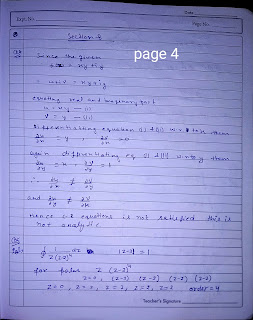Applied mathematics question with solution
Note remember page numbers
To separate the real and imaginary parts of log z, we put x = r cos q; y = r sin q
w = log z = log (x + iy)
⇒ u + iv = log (r cos q + ir sin q) = log r(cos q + i sin q) = loge
ANALYTIC FUNCTION
A function f (z) is said to be analytic at a point z0
, if f is differentiable not only at z0
but at
every point of some neighbourhood of z0
.
A function f (z) is analytic in a domain if it is analytic at every point of the domain.
The point at which the function is not differentiable is called a singular point of the function.
An analytic function is also known as “holomorphic”, “regular”, “monogenic”.
Entire Function. A function which is analytic everywhere (for all z in the complex plane)
is known as an entire function.
For Example 1. Polynomials rational functions are entire.
2. | | z 2 is differentiable only at z = 0. So it is no where analytic.
Note: (i) An entire is always analytic, differentiable and continuous function. But converse
is not true.
(ii) Analytic function is always differentiable and continuous. But converse is not
true.
(iii) A differentiable function is always continuous. But converse is not true
7.10 THE NECESSARY CONDITION FOR F (Z) TO BE ANALYTIC
Theorem. The necessary conditions for a function f (z) = u + iv to be analytic at all the
points in a region R are
(i)
y (ii) ∂
∂ , exist.
Proof: Let f (z) be an analytic function in a region R,
f (z) = u + iv,
where u and v are the functions of x and y.
Let du and dv be the increments of u and v respectively corresponding to increments dx and
dy of x and y.
\ f (z + dz) = (u + du) + i(v + dv)
Now f z z f z
since dz can approach zero along any path.
(a) Along real axis (x-axis)
z = x + iy but on x-axis, y = 0
\ z = x, dz = dx, dy = 0
Putting these values in (1), we have
′










Comments
Post a Comment